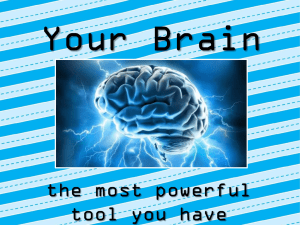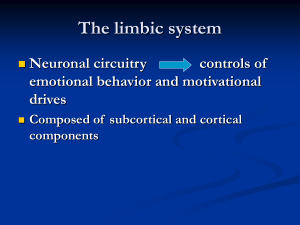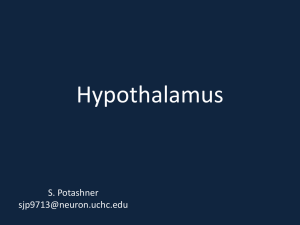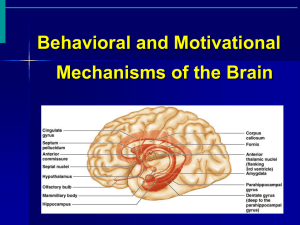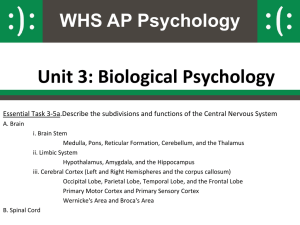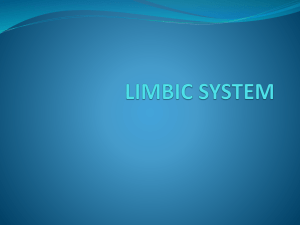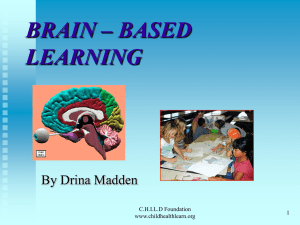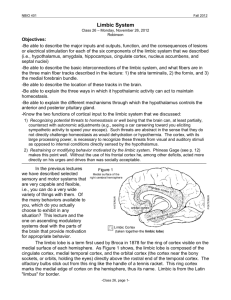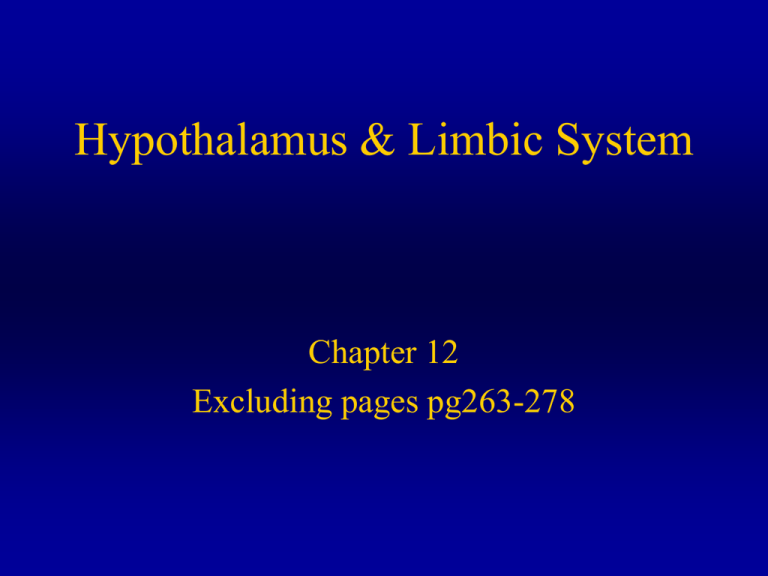
Hypothalamus & Limbic System
Chapter 12
Excluding pages pg263-278
Hypothalamus
Regulates Homeostasis
Hunger
Thirst
Body Temp, Blood Pressure
Sex Drives & Behavior
Emotions Via Limbic System
Pituitary Gland
Circadian Rhythms
Neuroanatomy of Hypothalamus
• Know the names of the nuclei on both
sections
– Periventricular, medial and lateral
– Preoptic anterior, middle and posterior
Neural Basis of Emotion
Fear, Anxiety, & Envy& Love, Joy
Role of Cingulate Gyrus, Amygdala,
Hypothalamus, Hippocampus
Emotions
• Emotional Experience
• Emotional Expression
• Input from senses
• Behavioral output
from somatic motor,
autonomic and
hypothalamus
• Processed by cerebral
cortex
Theories of Emotion
• James Lange Theory 1884
• Experience emotions IN RESPONSE to
physiological changes in our body
• Feel sad because we cry NOT cry because
we feel sad
• The emotion is the physiology
Cannon-Bard Theory
• 1927: Emotional experience can occur
independently of emotion expression
• Transect animal spinal cord and emotional
expression observed.
• Removal or damage to somatic sensory
system does not diminish emotion
experience.
Discrepency for James-Lange
• The same physiological characteristics can
occur without the emotion such as in illness
fever etc.
• Difference according to Cannon is the
activation of the thalamus (hypothalamus)
for the emotional response
Limbic Lobe 1878 Paul Broca
• identified medial
surface of cerebrum
that are different
from the rest of
cortex—called it
border=limbic lobe
• Cortex surrounding
corpus callosum
• Thought to be
involved in olfaction
Papez Circuit
• James Papez 1930s identified limbic
structures involved in emotion (added the
thalamic structures to the limbic lobe)
• Cingulate cortex to hippocampus to
hypothalamus via the fornix and from
hypothalamus to anterior nuclei of thalamus
• Neocortex connects to cingulate cortex
• Allows one to experience emotion
Limbic System
• Limbic Lobe and Papez Circuit together
• This distinguishes human emotions and
responses to situations from the
stereotypical response of animals due to
reflexive systems involving brainstem
Frontal Lobes of Cortex
• Provides Rationale Control of emotional
disposition & involved in personality
• Injury to frontal lobes causes change in
personality
• Control of emotions and impulse control
• Example of Phineas Gage
Pathologies
• Tumors and injury to areas of the brain lead
to emotional changes.
• Damage to cingulate cortex lead to
emotional disturbances: fear, depression,
irritability
Fear, Agression & Anxiety
Learned Fear, Anxiety & Temporal
Lobes and AMYGDALA
Kluver & Bucy Neuroscientist
• Remove bilateral temporal lobes and
monkeys cannot experience fear, approach
humans other monkeys and dangerous
situtations
• Cannot recognize objects by vision; called
psychic blindness-use mouth to identify
objects seen
• striking increase in sexual activity
Kluver-Bucy Syndrome
• Humans with temporal lobe lesions show
similar behavior as monkeys with temporal
lobectomy
• Have flattened emotions, don’t feel happy,
sad etc
Amygdala
• Neurons at the pole of the temporal lobe
below the cortex on the medial side
• Greek name for almond shape
• Has 3 nuclei, basolateral, corticomedial and
central
• Afferents from all lobes of neocortex &
hippocampus and cingulate gyrus
Input to Amygdala
• Basolateral nuclei receive sensory input
(visual, gustatory, auditory and tactile); also
projects to cortex for perception of emotion
• Corticomedial nuclei receive olfactory
inputs
• Central nuclei contain output neurons to
hypothalamus and periaqueductal grey in
brainstem for physiological responses
Damage to Amygdala
•
•
•
•
Decreases emotional response
Kluver-Bucy Syndrome=reduced emotionality
Fearlessness
SM human cannot recognize emotional
expressions on faces that are fearful, anxious &
angry but recognize happy & disgust
• Bilateral amygdala removal reduces memory
Electrical Stimulation of
Amygdala
• Cause affective rage when basalateral nuclei
is stimulated
• Corticomedial stimulation reduces
aggression
Learned Behaviors
• Require the amygdala and work through 2
pathways. Integrate information from all
sensory systems and orchestrate the
physiological and physchological response
– Ventral amygdofugal pathway
– Stria terminalis
Do Not learn
Pathway Names
Hypothalamus-brainstem
• Autonomic nuclei in the brainstem receive
synaptic input from hypothalamus via
– Medial forebrain bundle
– Dorsal longitudinal fasciculus
Aggressive Behaviors
• Androgen levels in males can
alter aggressive behaviors
• Predatory aggression: purpose is
getting food, little sympathetic
NS activity
– Medial hypothalamus
• Affective aggresion: purpose is
scare off enemies/protection
– Lateral hypothalamus
Hypothalamus and Rabies
• Rabies causes excess rage and aggression
• Rabies virus damages hypothalamic
neurons
• Led identification of hypothalamus as
critical brain area involved in anger
Electrical Stimulation of
Hypothalamus
• Depending on area, animal shows different
behaviors
• Associated with eating, sniff & eat
• Associated with fear or anger
• Demonstrates 2 functions of hypothalamus
– Metabolic regulation; homeostasis
– Coordinated somatic & visceral responses
Serotonin
• Serotonin containing neurons located in
Raphe nucleus in brainstem that project via
medial forebrain bundle to hypothalamus &
other limbic structures
• Aggressive mice have decreased serotonin
turnover
• Drugs that block serotonin release or
synthesis cause increase in aggression
Serotonin Receptors
• 14 5HT receptor subtypes
• Mice with no (knock-out) gene for 1A and
1B isoform, the type found in Raphe
Nucleus are more aggressive & anxious
when stressed otherwise act normally
• Specific agonist of 1A and 1B reduce
anxiety
Memory Systems
Hippocampus
Hippocampus & Relational
Memory
• Highly processed information from
association cortex areas enter hippocampus
• Hippocampus integrates them—ties them
together and then output is stored in other
cortical areas
• Allows you to retrieve all the information
about an event
Patients & Syndromes
• HM-mediotemporal lobe
• NA--thalamus
• Korsakoffs-thalamus & hypothalamus
Amnesia
• Anterograde
– Cannot form any new types of memories so
always live at time of injury
• Retrograde
– Cannot recall stored memories for a specific
time period
Memory
• Declarative: Explicit
– Facts & Events
• Easy to form, easy to
lose
• Medial Temporal Lobe
& Thalamus
• Non-Declarative: Implicit
• Takes repetition, hard to
lose
– Procedural
• Skills & Habits
– Striatum
– Classical Conditioning
• Skeletal Muscles
– Cerebellum
• Emotional Responses
– Amygdala
Conscious Recollection
• Only declarative memories & not nondeclarative memories
Declarative Memory
• Essential Anatomy
–
–
–
–
–
Medial Temporal Lobe
Entorhinal and Perirhinal, Parahippocampal Cx
Hippocampus
Fornix to Mammilary Body of Hypothalamus
Anterior & Dorsomedial Thalamus that project
to cingulate cx (limbic system)
HM
• Had bilateral mediotemporal lobes removed
due to epilepsy
• Removed amygdala, anterior 2/3 of
hippocampus, temporal cortex
• Had anterograde amnesia
• Studied by Brenda Milner
• Could learn by procedural memory but had
no recollection of having learned task
Squire & Mishkin
• Neuroscientists create an animal model for HM
symptoms
• Lesioned amygdala, hippocampus and perirhinal
cortex in temporal lobe of monkeys and found
that they could no longer perform in recognition
memory tests
• Later showed that perirhinal cortex is most
important for new memory; temporary storage?
Memory consolidation?
Diencephalon & Memory
Processing
• Anterior thalamic nucleus
• Dorsal Medial Thalamic nucleus
• Mammillary bodies in hypothalamus
Dorsal medial thalamic nucleus
• Receives input from temporal lobe
structures including amygdala &
inferiortemporal cortex
• Projects to all frontal cortex areas
NA
• Air Force technician injured by fencing foil
–penetrated the dorsalmedial thalamus
• Developed retrograde amnesia of previous 2
years and severe anterograde amnesia
• Supports role of thalamus in memory
Lashley
• Lashley: 1920s studied rats in maze after
cortical lesions
• Found that all cortical areas are involved in
memory
Hebb, Lashley student
• suggested CELL ASSEMBLY = all cells
that respond to an external stimulus & are
reciprocally interconnected
• Neurons that fire together, wire together
• 1949 Organization of Behavior
• Sensory cortex also stores memory
• Led to neural networks computer modeling
Circuit using limbic structures
• Hippocampal output axons travel as a
bundle, the fornix, to the mammillary
bodies of the hypothalamus
• Mammillary body axons project to anterior
thalamic nucleus
Definitions
•
•
•
•
•
Declarative & NonDeclarative
Long term & Short Term
Procedural & Working
Experience Dependent Brain Development
Anterograde and Retrograde Amnesia
Learning & Memory
• Adaptations of brain circuitry to life
experience
• Learning = acquisition of new information
or knowledge
• Memory = retention of learning
Long Term/Short Term Memory
• Long Term: last years but is selective
• Short term: last seconds to hours
Memory based on Vision
• Should be found in cortical area involved in
vision processing
• inferiortemporal cortex: higher order
processing of visual information—stores
memory of previously seen objects
• Allows recognition of visual objects
– Remember Kluver-Bucy pyschic blind
monkeys
Penfield
• Neurosurgeon in the 1950’s removed
epileptic foci after stimulation
• Found that stimulation of temporal lobe in
awake patients caused halucinations or
memory retrieval



